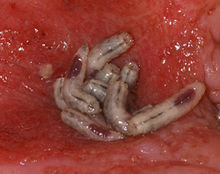- Maggot
-
In everyday speech the word maggot means the larva of a fly (order Diptera); it is applied in particular to the larvae of Brachyceran flies, such as houseflies, cheese flies, and blowflies,[1] rather than larvae of the Nematocera, such as mosquitoes and Crane flies. "Maggot" is not a technical term and should not be taken as such; in many standard textbooks of entomology it does not appear in the index at all.[2][3] In many texts (generally non-technical) the term is used for insect larvae in general, but this is likely to be misleading as well as pointless. Other sources have coined their own arbitrary, often vague, definitions, which is a frequent complication with non-technical terms; for example: "... The term applies to a grub when all trace of limbs has disappeared ..."[4] and "...Applied to the footless larvae of Dipters."[5]
Maggot-like fly larvae are of wide importance in ecology, economy, and medicine; among other roles, various species are prominent in recycling carrion and garbage, attacking crops and foodstuffs, spreading microbial infections, and causing myiasis.
Contents
Uses
Fishing
Anglers use maggots usually provided by commercial suppliers to catch non-predatory fish. Maggots are the most popular bait for anglers in Europe. Anglers throw handfuls into the "swim" they are targeting, attracting the fish to the area. The angler will then use the largest or "perceived" most attractive maggots on the hook, hoping to be irresistible to the fish.
Commercial maggot breeders from the UK sell their maggots to tackle dealers throughout the E.U. and North America.
In North America, maggots have been used for years mainly as ice fishing bait; recently, however, anglers have started using them year-round.
Medical treatment
Certain live maggots have been employed since antiquity as an economical, safe and effective type of wound debridement. In controlled and sterile settings by licensed medical practitioners, maggot therapy introduces live, disinfected maggots into non-healing skin or soft wounds of a human or other animal. They feed on the necrotic tissue, leaving live tissue largely unharmed. It is uncertain to what degree maggot secretions have any effect on bacterial growth, which or how useful any bacteriostatic effects might be, since different studies have produced contradictory results,[6][7] and some species of bacteria may be naturally resistant to maggot secretions.[8] As of 2008, maggot therapy was being used in around 1,000 medical centers in Europe and over 800 medical centers in the United States.[9]
Problems
As with fleas and ticks, maggots can be a threat to household pets and livestock, especially sheep. Flies reproduce rapidly in the summer months and maggots can come in large numbers, creating a maggot infestation and a high risk of myiasis in sheep and other animals. Humans are not immune to the feeding habits of maggots and can also contract myiasis.[10] Interaction between humans and maggots usually occurs near garbage cans, dead animals, rotten food and other breeding grounds for maggots.
A major problem arises when maggots mature into adult flies and start the life cycle over again. Within a few generations the number of maggots grows exponentially and becomes a serious problem. Professionals can remove maggots or many over-the-counter bug sprays can be used to deter flies and maggots. Keeping garbage in a sealed container and using a garbage disposal or freezing rotting leftovers until waste collection day helps prevent infestation. Sometimes introducing an environmental control, such as Histeridae, also help reduce maggot populations.
References
- ^ Brown, Lesley (1993). The New shorter Oxford English dictionary on historical principles. Oxford [Eng.]: Clarendon. ISBN 0-19-861271-0.
- ^ Comstock, John Henry, An Introduction to Entomology. Comstock publishing, 1930
- ^ Richards, O. W.; Davies, R.G. (1977). Imms' General Textbook of Entomology: Volume 1: Structure, Physiology and Development Volume 2: Classification and Biology. Berlin: Springer. ISBN 0-412-61390-5.
- ^ Jardine, N. K. The Dictionary of Entomology. 1913
- ^ Smith, John. B. Explanation of terms used in entomology. Pub: Brooklyn Entomological Society 1906. May be downloaded from: [1]
- ^ Cazander G, van Veen KE, Bernards AT, Jukema GN (April 2009). "Do maggots have an influence on bacterial growth? A study on the susceptibility of strains of six different bacterial species to maggots of Lucilia sericata and their excretions/secretions". J Tissue Viability 18 (3): 80–7. doi:10.1016/j.jtv.2009.02.005. PMID 19362001.
- ^ Daeschlein G, Mumcuoglu KY, Assadian O, Hoffmeister B, Kramer A (2007). "In vitro antibacterial activity of Lucilia sericata maggot secretions". Skin Pharmacol Physiol 20 (2): 112–5. doi:10.1159/000097983. PMID 17167275.
- ^ Jaklic D, Lapanje A, Zupancic K, Smrke D, Gunde-Cimerman N (May 2008). "Selective antimicrobial activity of maggots against pathogenic bacteria". J. Med. Microbiol. 57 (Pt 5): 617–25. doi:10.1099/jmm.0.47515-0. PMID 18436596.
- ^ Maggot debridement therapy DermNet NZ, 19 February 2010
- ^ http://www.hindustantimes.com/Doctors-remove-100-live-maggots-from-a-75-year-old-woman-s-nose/Article1-746653.aspx
External links
- Maggot Therapy Project website at the University of California, Irvine, list of maggot therapy practitioners
- BioTherapeutics Education and Research Foundation
- Get rid of Maggots Website with visitors' input on getting rid of maggots
- Biotherapy with leeches and maggots
Categories:- Flies
- Developmental biology
- Coprophagous animals
Wikimedia Foundation. 2010.


